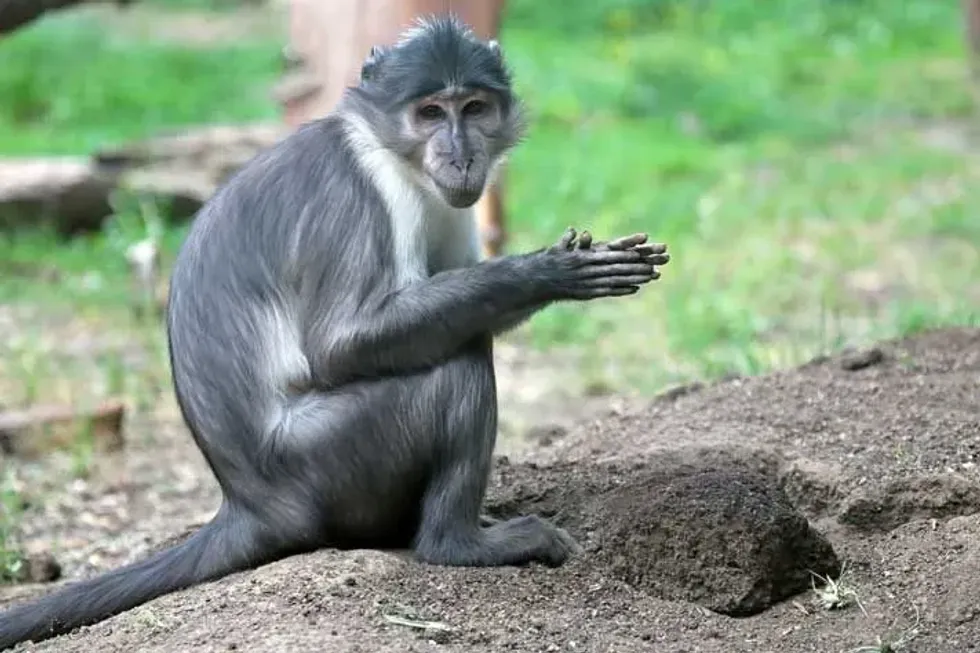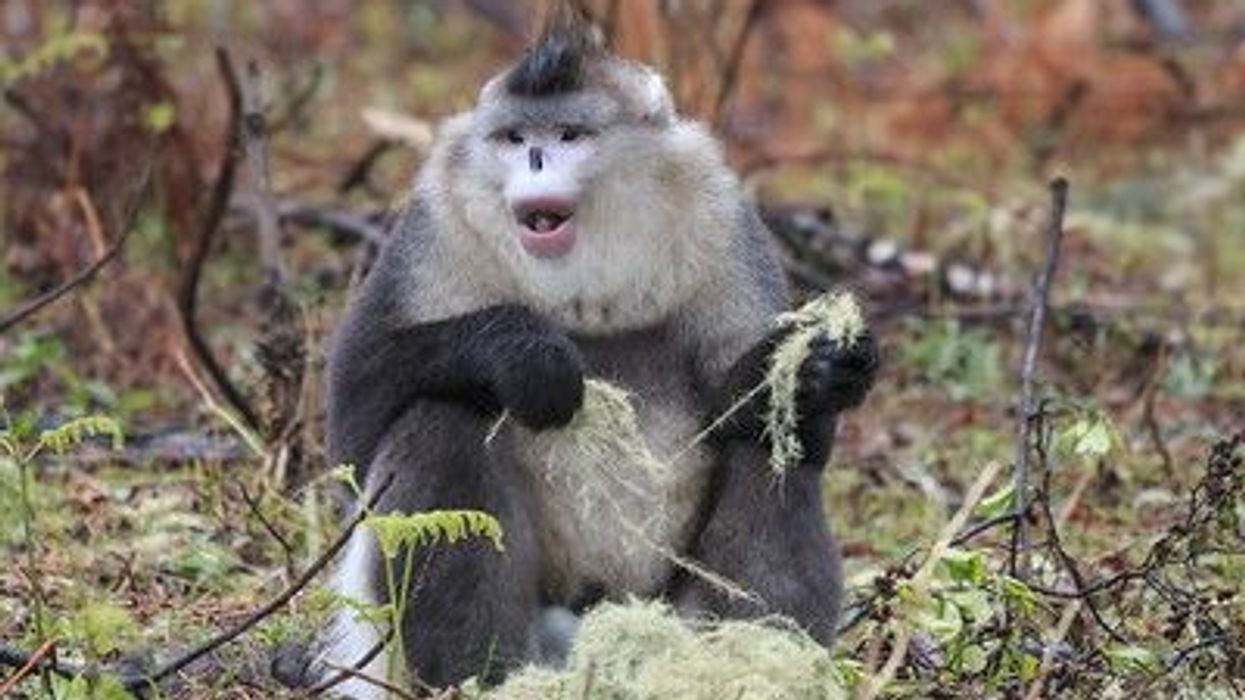The sooty mangabey (Cercocebus atys) is an important link and case study for one of our gravest diseases, AIDS, or Human Immunodeficiency Virus. These Old World monkeys originate in West Africa and are currently found in the Taï National Park of the Côte d'Ivoire region and Guinea Bissau.
These monkeys belong to the genus Cercocebus, which contains other mangabey species like the white-naped mangabey and the white-collared mangabey.
Sooty mangabeys live in groups containing 70-120 individuals in multi-male or multi-female groups and have various calls for social interactions. Most of its time is spent on the forest ground, foraging for fruits and nuts, but it can also climb trees to evade predators.
These monkeys are naturally infected by the Simian Immunodeficiency Virus (SIV), termed the sooty mangabey HIV or SIVsmm. Even though these monkeys aren't affected by the virus, it can easily transfer to other animals and even humans.
When humans are affected, the Simian Immunodeficiency Virus (SIV) takes the form of HIV-2. The extensive study can help to know more about the host, sooty mangabeys, along with SIV and its presence in the wild.
Want to know more about the primates? Keep reading to learn interesting sooty mangabey facts. Also, check out the articles on tree kangaroo and black spider monkey.
Sooty Mangabey Interesting Facts
What type of animal is a sooty mangabey?
The sooty mangabey (Cercocebus atys) is a species of Old World monkey native to west Africa.
What class of animal does a sooty mangabey belong to?
Sooty mangabeys belong to the class Mammalia and the genus Cercocebus, like most mangabey. This primate is from the Old World monkey family that contains species like langur monkeys.
How many sooty mangabeys are there in the world?
The exact demographic of the sooty mangabeys population is yet to be found. However, a 2009 survey done in the Taï National Park found the population to be around 63,000 individuals. It has been estimated that the population of these African primates has declined by almost 20-25% in recent years.
Where does a sooty mangabey live?
The sooty mangabey (Cercocebus atys) is native to West Africa, and it is primarily found in the coastal areas of Upper Guinea. Originally, the range of these primates stretched between Senegal's Casamance River to the Ivory Coast's Sassandra/Nzo River system. The population of this species can now be found in Sierra Leone, the western Ivory Coast, and Liberia.
What is a sooty mangabey's habitat?
The primary habitat of sooty mangabeys is in the valleys of the Guinean Forest Zone, where these primates reside in primary, secondary, flooded, dry, mangrove, and mosaic forests. The monkeys can also choose swamp forests or palm forests as their habitat. These primates prefer to live in areas with an elevation of less than 3280.8 ft (1000 m).
Who do sooty mangabeys live with?
As a primate species, sooty mangabeys are known for living in groups of 70 to 120 monkeys. Multi-male and multi-female groups are quite common for this Old World monkey.
A linear hierarchical pattern is seen in the groups where high-ranking males and females get better treatment and spend minimal time foraging for food. Interestingly, females of this species are likely to be in the central position in groups compared to the males.
How long does a sooty mangabey live?
The average lifespan of the sooty mangabey monkeys is around 18 years of age in the wild. When kept in captivity, sooty mangabeys can manage to live to be 26 years old.
How do they reproduce?
Like other primates, the reproductive system of the sooty mangabey (Cercocebus atys) is quite interesting. The common breeding season for the sooty mangabey is between May to September, and mating takes place every 13-16 months.
These monkeys are polygynandrous in nature, so both males and females have multiple sexual partners. The highest-ranking males of a group get the first chance to mate with females. When adult females go through estrus, it has perineal sexual swellings, which acts as a signal to males.
Males are keen on performing genital inspections before mounting a female. A grunting noise is often made by the female sooty mangabeys during mating.
The gestation period in these monkeys lasts for 160 to 170 days, and females typically give birth to a single infant.
Mothers play an important role in taking care of the infants for the first seven months, and the females carry the infants on its ventral side for the first few months.
Infanticide is common in this species, where because of its jealous behavior, males will often kill infants of other males. If the infant is killed within six months of its birth, the mother immediately goes into an estrus cycle, and the intruding males often try to mate within this time.
Most infants are weaned after 10 months, and males reach sexual maturity at the age of four years.
What is their conservation status?
Currently, the sooty mangabey is listed as Vulnerable in the International Union for Conservation of Nature (IUCN) Red List.
Sooty Mangabey Fun Facts
What do sooty mangabeys look like?
Sooty mangabeys are mostly known for their sooty gray or slate gray fur present on their dorsal side. These monkeys have white or pale gray fur on their chest or ventral side.
Extremities are darker than the rest of the body, while the bare face is either gray or has a pink salmon color to it. Dark fur is also seen on the head and on the ears.
Males are larger than females, but both look quite similar. These monkeys have strong molars allowing them to crack through the hardest of nuts.
How cute are they?
Just like the white-naped mangabey, the sooty mangabey also looks quite cute because of its fluffy gray fur and its flushed face.
How do they communicate?
Sooty mangabey monkeys are known for their various communication techniques, such as the whoop gobbles, one of the low-frequency calls made by the male. Another of its popular calls is soft and rapid grunts.
Females and infants also make twitter calls, especially while foraging on the forest ground. When predators are close, both males and females can make alarm calls to notify a group.
How big is a sooty mangabey?
The average height of the sooty mangabey is 14.9-17.7 in (38-45 cm), while the average body length is 15.7-26.3 in (40-67 cm). If we compare a chimp and sooty mangabey, the former is much larger with an average length of 4 ft 11 in (150 cm). Chimpanzees are common predators of the sooty mangabey.
How fast can a sooty mangabey move?
Not much is known about the speed of sooty mangabeys. However, as a quadrupedal animal, the sooty mangabey mostly travels on its four limbs.
How much does a sooty mangabey weigh?
The average weight range of the sooty mangabey is between 11-30.8 lb (5-14 kg).
What are the male and female names of the species?
There are no distinct names for the male and female of the species.
What would you call a baby sooty mangabey?
A baby sooty mangabey is called an infant.
What do they eat?
The sooty mangabey species is primarily herbivores, and its diet mainly consists of fruits and nuts. Palm nuts take up a huge portion of the diet, closely followed by parts of swamp plants.
At times these monkeys can also munch on invertebrates. Its diet can also include grass and other vegetation found in its natural habitat of flooded, dry, or gallery forests. Sooty mangabeys also have cheek pouches that help in storing fruits and nuts while foraging on the forest floor.
Are they poisonous?
No, these animals are not poisonous in nature. However, these monkeys are naturally infected with the Simian Immunodeficiency Virus (SIV). Even though these monkeys aren't affected by the virus, it can be passed on to other primates and even to humans.
This sooty mangabey disease is seen as a progenitor to the HIV-2 disease seen in men. Research also helps to study the HIV chimp sooty mangabey human tree to know more about the transmission. Sooty mangabeys can transmit the virus to other monkey species like colobus monkeys.
Would they make a good pet?
No, the wild sooty mangabey (Cercocebus atys) isn't the best pet to have. Moreover, these monkeys are naturally infected by the Simian Immunodeficiency Virus (SIV), which can take the form of HIV-2 in humans.
Did you know...
Sooty mangabey's behavior is to spend 75% of time traveling on ground as well as foraging for food.
Are sooty mangabeys endangered?
The sooty mangabey monkey is currently classified as Vulnerable in the IUCN Red List rather than being endangered. Apart from the usual predation by potential predators, the groups are also vulnerable to human hunting.
These animals are also important for studying more about HIV, which is closely related to the Simian Immunodeficiency Virus (SIV) as the sooty mangabey monkeys are naturally infected by it.
How did the sooty mangabey get its name?
The sooty mangabey (C. atys) gets its name from the sooty or dark gray fur covering its body. The sooty mangabey is closely related to the white-collared mangabey (Cercocebus lunulatus), formerly thought to be a subspecies of the former species but are now classified as separate species.
The white-collared mangabey was formerly classified as the Cercocebus atys lunulatus. Also, the white-collared mangabey is different from collared mangabeys.
Here at Kidadl, we have carefully created lots of interesting family-friendly animal facts for everyone to discover! For more relatable content, check out these baboon facts and gibbon facts pages.
You can even occupy yourself at home by coloring one of our free printable sooty mangabey coloring pages.










